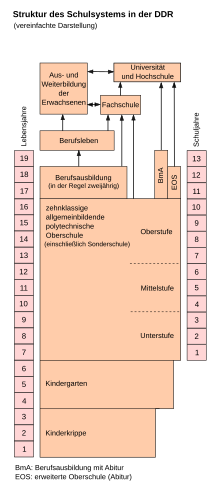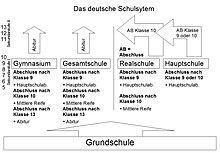School history (Germany)
This article deals with the historical development of school teaching in Germany.
development
Convent schools in the Middle Ages
From the 5th century, the church established itself as an educational institution. The Church preserved ancient knowledge in large libraries and spread it across Europe, even to Ireland.
The monastery schools also differentiated themselves into internal and external schools. The purpose of the inner school was to train new monks and nuns , while the outer school trained lay children, mostly young nobles. Classes were held in Latin . In addition, the focus was on the Septem artes liberales , i.e. the seven liberal arts: the so-called trivium , i.e. the linguistic-logical subjects, comprised grammar, rhetoric and dialectics, the quadrivium , the mathematical subjects, geometry, arithmetic, music and astronomy. Famous monastery schools were to be found in St. Gallen , Reichenau and Fulda . Charlemagne founded court academies as well as court and collegiate schools and even tried to introduce compulsory schooling .
City schools
Around the year 1250, the city school was established alongside the monastery school. The teaching people were no longer just monks but also secular teachers. The language of instruction also changed from Latin to German. The teaching method continued to be cruel and brutal. The so-called angle schools , private institutions, in which often only poorly educated teachers and clerics were active as teachers with the permission of the city council , were little respected .
School in the Age of Reformation and Enlightenment
In the course of the 17th century, a new ideal of education developed, realism , the way people think now, along with the natural sciences, came first. The schools were institutionalized, and children and young people were increasingly taught according to plan. The famous phrase “omnes omnia omnino” (teaching everyone thoroughly) also comes from this period. Johann Comenius introduced a four-level school system and the large teaching system, which was supposed to give all children access to education.
School in the 19th century
At the beginning of this century the first features of the modern school system developed. A giant step was taken towards the child in education and pedagogy in order to prepare it for the life to come. In what was then Prussia , highly respected people like Wilhelm von Humboldt campaigned for the introduction of the so-called elementary school , the forerunner of elementary school . As a further form of school to prepare for a university education were high schools founded. In 1837 compulsory curricula were introduced, which counteracted the arbitrariness of the subject matter at the time . As less demanding alternatives, middle schools emerged , which should prepare for a position as a middle civil servant. The schools, which used to be privately or clerically run, were increasingly nationalized and compulsory schooling was successfully enforced; in 1816 46% of school-age children were registered in schools and in 1846 60%.
School in the Weimar Republic and National Socialism
The primary school was standardized by the Reich Primary School Act of 1920, and no distinction was made between a school for the poor and a school for the rich. However, major reforms failed due to the political situation. Left-wing parties such as the Social Democrats advocated a separation of church and school, while conservative forces were vehemently against it.
During the time of the Nazi regime , the school system hardly changed, but the content changed under the political and ideological influence of the state. The cruel and inhuman ideologies of the National Socialists found their way into the classroom, Jews were gradually banned from attending school and teaching.
School in the GDR
In contrast to the FRG , the school system was strictly centralized and subordinated to the Ministry of Popular Education . The eight-year elementary school was introduced with the so-called uniform school law. The four-year high school for the Abitur or the two-year middle school followed . In 1959, the GDR passed the law on the socialist development of the school system. The ten classes of the polytechnic high school were now compulsory for all . This was followed by the two-year extended high school (EOS), which led to the Abitur; until 1981 the lessons at the EOS began after the 8th grade. There was also the three-year vocational training with a high school diploma. Another essential difference to the western school system: At the end of the 1970s, the government introduced military instruction in grades 9 and 10 .
After the fall of the Berlin Wall , the system of the FRG was adopted, but the Abitur was retained after twelve years.
School in Germany
After the end of the Second World War , the three-tier school system known to this day was introduced ( elementary school (instead of elementary school ), secondary or secondary school and grammar school ). The administration of the schools was decentralized to the federal states . However, the Standing Conference of the Ministers of Education and Cultural Affairs of the Federal States (KMK) was founded, which ensures the necessary degree of common ground on supraregional issues, for example the comparability of certificates .
Individual evidence
- ^ Gregor Delvaux de Fenffe / Martina Frietsch: Learning: School history . July 14, 2017 ( planet-wissen.de [accessed September 5, 2017]).
- ^ Monastery school - Middle Ages Lexicon. Retrieved December 19, 2018 .
- ^ City School - Middle Ages Lexicon. Retrieved December 19, 2018 .
- ^ Gregor Delvaux de Fenffe / Martina Frietsch: Learning: School history . July 14, 2017 ( planet-wissen.de [accessed September 5, 2017]).
- ^ Louisa Reichstetter: Pedagogy: From command to role model . In: The time . March 2, 2017, ISSN 0044-2070 ( zeit.de [accessed September 5, 2017]).
- ^ Gregor Delvaux de Fenffe / Martina Frietsch: Learning: School history . July 14, 2017 ( planet-wissen.de [accessed September 5, 2017]).
- ↑ Eva-Maria Hetterich: school earlier. Retrieved September 5, 2017 .
- ↑ Reinhard Diethmar (ed.): School and instruction in the Third Reich. Neuwied 1985.
- ^ Kurt-Ingo Flessau: School and dictatorship. National Socialism curricula and school books. Munich 1977.
- ^ Renate Fricke-Finkelnburg (ed.): National Socialism and School. Official edicts and guidelines 1933–1945. Opladen 1989.
- ^ Gregor Delvaux de Fenffe / Martina Frietsch: Learning: School history . July 14, 2017 ( planet-wissen.de [accessed September 5, 2017]).
- ↑ School and Education | Everyday life | Nazi era | Time clicks. Retrieved September 5, 2017 .
- ^ Gregor Delvaux de Fenffe / Martina Frietsch: Learning: School history . July 14, 2017 ( planet-wissen.de [accessed September 5, 2017]).
- ↑ At school | Childhood in the GDR | Everyday life | GDR | Time clicks. Retrieved September 5, 2017 .
- ^ Gregor Delvaux de Fenffe / Martina Frietsch: Learning: School history . July 14, 2017 ( planet-wissen.de [accessed September 5, 2017]).
- ↑ School then-now. Retrieved September 5, 2017 .

